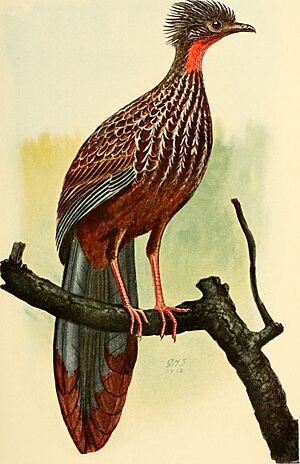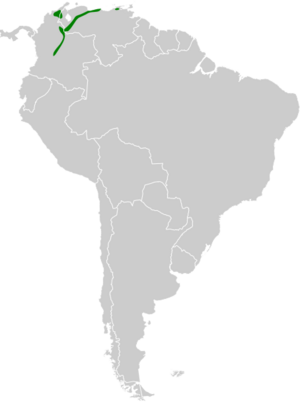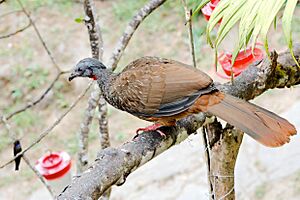Band-tailed guan facts for kids
Quick facts for kids Band-tailed guan |
|
|---|---|
 |
|
| Penelope argyrotis | |
| Conservation status | |
| Scientific classification | |
| Genus: |
Penelope
|
| Species: |
argyrotis
|
 |
|
The band-tailed guan (Penelope argyrotis) is a cool bird that lives in the forests of Colombia and Venezuela. It's part of a bird family called Cracidae, which includes other interesting birds like chachalacas, guans, and curassows. These birds are known for living in trees and eating fruits.
Contents
Meet the Band-tailed Guan's Family
Scientists like to group living things to understand them better. This is called taxonomy. The band-tailed guan is closely related to another bird called the bearded guan. Some people even thought they were the same species at one point!
Different Types of Band-tailed Guans
The band-tailed guan has three main types, called subspecies:
- P. a. argyrotis (the main one)
- P. a. albicauda
- P. a. colombiana
Sometimes, P. a. colombiana was thought to be its own species. But most scientists agree there are three subspecies.
What Does the Band-tailed Guan Look Like?
This bird is about 50 to 61 cm (1.6 to 2.0 ft) long. That's about the size of a small dog! Males weigh around 686 to 981 g (1.5 to 2.2 lb), and females are a bit lighter, weighing 625 to 900 g (1.4 to 2.0 lb).
Colors and Features
The main type of band-tailed guan, P. a. argyrotis, has dark brown feathers on its back. These feathers often have cool white stripes. Its chest is olive brown, and its belly is a lighter brown.
One of its most noticeable features is its face. It's pale gray or white. It also has a bright red dewlap, which is a flap of skin under its chin. The bird gets its name from the wide, chestnut-colored band on its tail.
How Subspecies Differ
- P. a. albicauda has buffy (light yellowish-brown) tips on its tail feathers.
- P. a. colombiana has more white on its head and less white on its face compared to the main type.
Where Do Band-tailed Guans Live?
These birds live in the beautiful mountains and coastal areas of Colombia and Venezuela.
Specific Locations
- The main subspecies, P. a. argyrotis, lives in the eastern Andes mountains of Colombia and western Venezuela. You can also find it in the Venezuelan Coastal Range.
- P. a. albicauda lives in the Serranía del Perijá mountains in northern Colombia and northwestern Venezuela.
- P. a. colombiana is found only in the Sierra Nevada de Santa Marta in northern Colombia.
Their Favorite Homes
Band-tailed guans mostly prefer thick, wet, untouched forests. However, they can sometimes be seen in forests that have grown back after being cut down. They also live in coffee farms that have shade trees, and even in drier forest areas higher up in the mountains.
They usually live at elevations from 550 to 2,000 m (1,800 to 6,560 ft) in the Sierra Nevada de Santa Marta. In Venezuela, they are typically found between 800 to 2,400 m (2,600 to 7,900 ft) high. Sometimes, they can be found much higher or lower than these usual spots.
Band-tailed Guan Behavior
What Do They Eat?
Band-tailed guans usually look for food in small groups of up to six birds. If there's a tree full of fruit, you might see even more of them! They love to eat fruit, usually picking it from the middle parts of trees. But they will also eat fruit that has fallen to the ground.
How Do They Raise Their Young?
The breeding season for band-tailed guans is from January to May. They are territorial, meaning they protect their own space. However, several families might live close to each other. Their nest is a simple structure made of plant materials. They build it high up in a tree, sometimes as high as 8 m (26 ft) off the ground.
Sounds They Make
Band-tailed guans have special ways to communicate. They use a unique wing-rattling sound to show where their territory is. It sounds a bit like "canvas ripping forward, then in reverse." When they are a little worried, they make "soft, piping whistles." If they are really scared, they let out a repeated, shrieking "GUEEA!" mixed with some gruff noises.
Protecting the Band-tailed Guan
The IUCN (International Union for Conservation of Nature) has looked at the band-tailed guan's situation. They have assessed it as a species of "Least Concern." This means it's not currently in great danger of disappearing.
The bird is fairly common in most places where it lives. In Venezuela, it even lives in several protected areas. However, these birds still face threats. The biggest problems are deforestation (when forests are cut down) and hunting. Protecting their forest homes is very important for their future.



